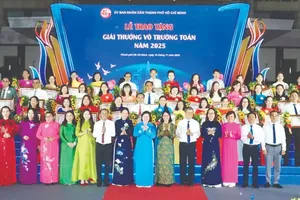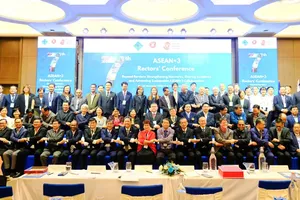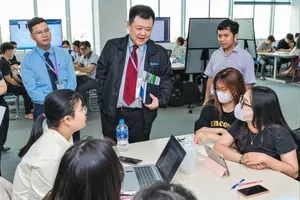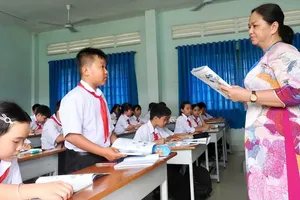
Strategic requirement
Prof Dr Huynh Van Son, President of HCMC University of Education informed that the next five years are viewed as a critical period for implementing the Education Development Strategy to 2030 (with a vision to 2045) and the Planning of the Higher Education and Pedagogical Institution Network for 2021-2030 (with a vision to 2050).
This is also the era where the entire sector will synchronously deploy the 2018 General Education Program (GEP), accelerate digital transformation, and expand international integration, all aiming to develop high-quality human resources for sustainable growth.
Politburo Resolution No. 71-NQ/TW on breakthrough development in education and training explicitly states: “The school is the foundation, the teacher is the driving force, deciding the quality of education and training.”
Among the eight groups of solutions mentioned, Resolution 71 sets a firm requirement: “Arrange sufficient staffing quotas for teachers and employees according to prescribed standards; improve the quality of training and fostering for teachers and educational administrators; and vigorously implement preferential policies to attract excellent students to the pedagogical field.”
Strengthening teacher workforce development is now a strategic mission, necessitating a pivot from content-based to competency-based training to address modern education’s rapid evolution. Currently, however, the training network remains plagued by inadequacies. Capacity varies wildly, resulting in acute localized shortages for subjects like Arts, English and Informatics, particularly in disadvantaged regions.
Furthermore, the quality gap between areas remains vast, while digital adaptability among staff is limited and remuneration schemes lack sufficient motivational power. Compounding this, the implementation of the two-tier local government model has exposed a dearth of specialized education officials at the grassroots level, significantly undermining the effective management and deployment of the 2018 General Education Program.
Innovating teacher training must be approached as comprehensive restructuring along key lines:
- standardizing curricula,
- basing output on professional competency,
- integrating digital and innovation skills,
- obtaining a network of practice or satellite schools to ensure students undergo continuous, practical professional training,
- internationalizing curricula,
- expanding credit recognition,
- facilitating student and lecturer exchanges, aiming for compatibility within ASEAN and internationally,
- accelerating quality accreditation and the implementation of autonomy.
Synchronized solutions
Building a teaching workforce that is sufficient in quantity, strong in quality, synchronized in structure, and capable of innovation, digital competency, and professional ethics to meet the demands of the 2018 GEP and national digital transformation is an urgent requirement.
To achieve this goal, four synchronized solutions must be implemented:
- Teacher Training: The dominant orientation is to standardize and modernize training programs based on a professional competency approach, integrating digital technology and enhancing practice at general education institutions.
- Developing the General Teacher Workforce: Professional fostering needs to shift from mass training to personalized development, based on competency and job position. Each teacher should be supported in building an electronic professional competency profile, accessing a national open learning platform, and using a modular online training system to update digital teaching, integrated teaching, and student quality development skills.
- Management and Policy: Recruitment, utilization, evaluation, and remuneration mechanisms must be innovated. Simultaneously, management agencies need to establish a Teacher Workforce Development Fund.
- Digital Capacity and Integration: Enhance digital capacity and international integration for teachers according to the UNESCO competency framework, helping them use IT and participate in digital teaching environments.
Overall, the development orientation for the teaching workforce over the next 5-10 years needs to place the center of gravity on improving quality, professional competency, and adaptability, rather than simply expanding the scale of training.
Minister of Education and Training Nguyen Kim Son highlighted a dramatic turnaround following the Law on Teachers’ enactment in June 2025. Previously, the sector faced a 10 percent attrition rate, mostly among those under 35, alongside chronic recruitment struggles and low entrance standards.
Post-legislation, new salary policies have revitalized the field. Pedagogical schools now command high benchmark scores, while recruitment applications have surged, even for scarce subjects like Informatics and Arts.
Currently, educators eagerly await detailed regulations positioning teacher salaries at the pinnacle of the administrative scale. The Ministry of Education and Training is actively coordinating with the Ministry of Finance to secure the necessary budget, ensuring these ambitious policies remain financially feasible given the nation’s socio-economic context.
While acknowledging consensus on the draft education laws, Dr Hoang Ngoc Vinh, former Director of the Department of Professional Education (Education and Training Ministry) argues crucial adjustments remain.
He insists the Ministry of Education and Training must move beyond merely listing vocational and continuing education, instead defining their specific roles within a unified system linked to long-term national planning. Furthermore, he calls for a fundamental mindset shift from “top-down management” to “ensuring learners’ rights.” Policies must prioritize learning opportunities over budget constraints to break the current vicious cycle.
The law must state clearly that learners have the right to access a program with transparent output standards and acceptable quality at an appropriate cost. The State has the responsibility to use financial policy to protect those rights, especially for preschool children and students in difficult areas.
Simultaneously, the viewpoint of building a learning society should be clearly affirmed, viewing lifelong learning as a right and natural need of every citizen. Learning at the workplace and within enterprises must be recognized, with mechanisms for result recognition and transferability.
Regarding teachers, the National Assembly has discussed deeply about preferential allowances, and how preschool and primary teachers’ salaries are not enough to live on. The Education and Training Ministry cannot just note the opinions and wait for the Ministry of Home Affairs or Ministry of Finance.
Right in the law and in principle, it must be clearly stated that teachers are a force that needs to be guaranteed a minimum income sufficient to live and raise children, commensurate with the specific nature of the profession, rather than paying salaries based on the structure of training levels and school levels.
























